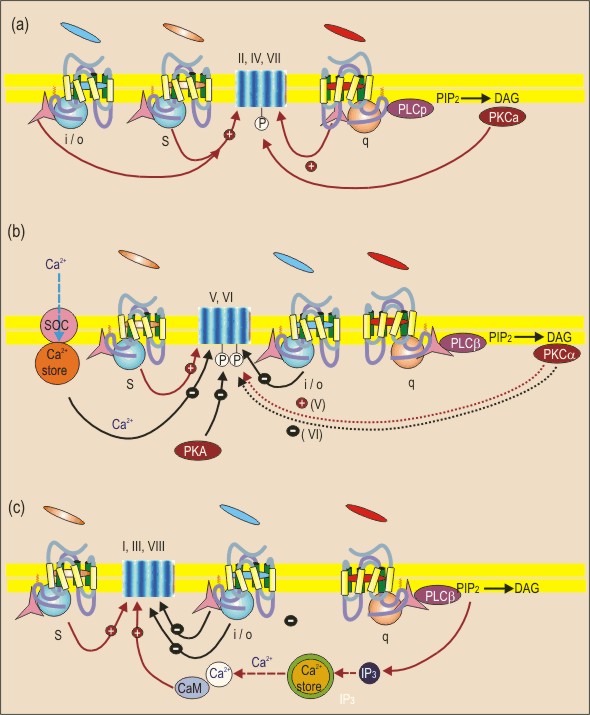Gene: [ALP/02q37] alkaline phosphatase gene cluster 2q37; (ALPIA ALPIF ALPPR ALPT)
|
SUM |
[1] Currently five isoforms of alkaline phosphatase (ALP) encoded each
by an individual gene are definitely known. These are the
liver/bone/kidney (GEM:01p3/ALPL), the
postnatal (GEM:02q371/ALPIA), and
the fetal (GEM:02q37/ALPIF) intestinal
isoforms; as well as the
placental (GEM:02q371/ALPPR) and the
testicular/T-cell or placental
alkaline phosphatase-like (GEM:02q37/ALPT)
isoforms. The genes for four
isoforms (except for ALPL) are located in 2q37. Being highly homologous
(by both amino acid and nucleic acid sequences, due to the
common evolutionary origin from a single ancestral gene through the
duplications), they are likely to form a tandem. However, a precise
physical map of this region is not available yet.
[2] It was previously supposed (Kam-1985) that the gene for placental alkaline phosphatase-like ALP is located in chromosome 17. However, it was found lately that it is most probably located in the common ALP cluster in 2q37. This isoform is found in the testicular tissue, thymus, and probably placenta. The name 'placental alkaline phosphatase-like' is accounted for by the high homology with the placental ALP with respect to primary structure." |
|
FUN |
[1] The enzyme has wide specificity. It catalyzes hydrolysis of
orthophosphoric monoesters as well as transphosphorylation.
[2] Systematic name: orthophosphoric-monoester phosphohydrolase (alkaline optimum) The catalyzed reaction: an orthophosphoric monoester + H(2)O = an alcohol + orthophosphate." |
|
HET |
The MIM Catalogue describes two other markers that concern ALP expression: a serum ABO/SE-associated isoform (MIM:171700; not reserved in the HGM and GEM catalogues because of data uncertainty) and the factor of elevated activity of different serum ALP forms (MIM:171720; unidentified yet)." |
|
NOM |
The GEM catalogue adopted formally more rigorous denotation of the symbols for placental (isoenzyme Regan) and placental alkaline phosphatase-like (Nagao) isoforms: ALPPR (ALP, Placental, Regan) and ALPT (ALP, Testicular). It was necessary because the denotation adopted in the HGM catalogues (ALPP and ALPPL, respectively) would allow to interpret these symbols as 'ALP pseudogene' and 'ALPP-like sequence'." |
|
PAT |
On the hypophosphatasias resulted from deficiency of the hepatic isoform, see GEM:01p3/ALPL:HET." |
|
REL |
GEM:02p25/ACP1. |
|
REF |
FUN,PEP "Badger, Sussman: PNAS, 73, 2201-2205, 1976 HET "Beckman &: Acta Genet Statist Med, 16, 305-312, 1966 PRO,SEQ,EXP "Berger J &: PNAS, 84, N3, 695-698, 1987 PHE,FOG,POP "Boyer SH: Science, 134, 1002-1004, 1961 PHE,FOG,POP "Donald LJ: Ann Hum Genet, 38, N1, 7-18, 1974a PHE,FOG,POP "Donald LJ, Robson: Ann Hum Genet, 37, 303-313, 1974b HET "Ducobu, Dupont: Lancet, 1, 1372-1373, 1981 FUN,PEP "Garattini &: PNAS, 82, N18, 6080-6084, 1985 PHE,FOG,POP "Gogolin &: PNAS, 78, 5061-5065, 1981 FUN,PEP "Goldstein &: PNAS, 77, 2857-2860, 1980 LOC,PRO "Griffin CA &: AJHG, 41, 1025-1034, 1987 GEN,SEQ,POL "Henthorn PS &: JBC, 263, N24, 12011-12019, 1988 PRO,SEQ,EXP "Henthorn PS &: PNAS, 84, N5, 1234-1238, 1987 PRO,SEQ,EXP "Henthorn PS &: PNAS, 83, N15, 5597-5601, 1986 FUN,PEP "Hua J-C &: PNAS, 83, N8, 2368-2372, 1986 LOC,PRO,SEQ,EXP "Kam W &: PNAS, 82, 8715-8719, 1985 GEN,SEQ,POL "Knoll BJ &: JBC, 263, N24, 12020-12027, 1988 PRO,SEQ,EXP "Knoll BJ &: Gene, 60, 267-276, 1987 FUN,PEP "Lehmann FG: BBA, 616, N1, 41-59, 1980 PHE,FOG,POP "Lucarelli &: AJHG, 34, 331-336, 1982 LOC,PRO "Martin D &: Ann Hum Genet, 51, 145-152, 1987a GEN,SEQ,POL "Martin D &: NAR, 15, 9104, 1987b HET "McEvoy &: Brit Med J, 282, 1272, 1981 GEN,SEQ,POL "Millan JL, Manes: PNAS, 85, N9, 3024-3028, 1988 FUN,PEP "Mueller &: BBRC, 126, N1, 427-433, 1985 PHE,FOG,POP "Palmarino &: Hum Biol, 51, 341-352, 1979 LOC,PRO "Raimondi E &: CCG, 47, 98-99, 1988 REV,PHE,FOG,POP "Robinson, Goldsmith: Vox Sang, 13, 289-307, 1967 PHE,FOG,POP "Robson, Harris: Nature, 207, 1257-1259, 1965 PRO,SEQ,EXP "Shen LP &: NAR, 16, N12, 5694, 1988 HET "Shreffler DC: AJHG, 17, 71-86, 1965 GEN,SEQ,POL "Tsavaler L &: PNAS, 84, N13, 4529-4532, 1987 HET "Wilson JW: New Engl J Med, 301, 983-984, 1979 |

